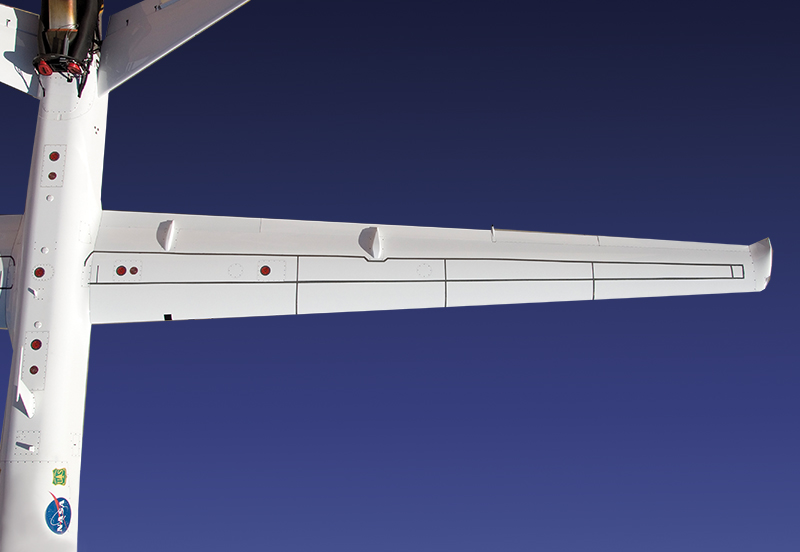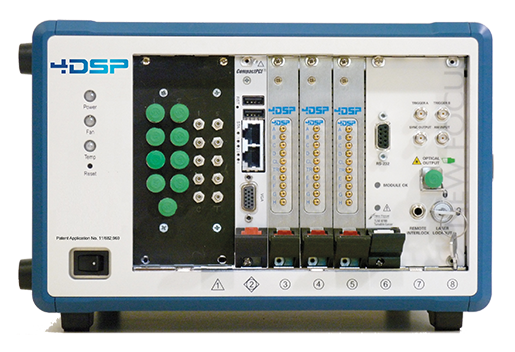
Fiber Optics Deliver Real-Time Structural Monitoring
NASA Technology
If the wings of a plane could talk about what they feel during flight, what would they say? Engineers at Dryden Flight Research Center are beginning to find out.
Having access to real-time information about wing shape, stress, temperature, pressure, and strength could enable adjustments to aircraft wings to maximize aircraft performance—and affect everything from safety to efficiency. To develop the capability to alter the shape of wings during flight, researchers at Dryden Flight Research Center need to know what is happening when it is happening.
Traditionally, large, heavy instrumentation is used for taking measurements about shape and forces applied on wings during flight, but this instrumentation is bulky, slow, and limited. After the sensors acquire the data, they have to send it to a computer for processing. After that, it is translated and then analyzed.
In the 1990s, Dryden started looking for smaller, lighter alternatives to use as sensors on aircraft wings to deliver real-time data. One of the options was fiber optics, or flexible, transparent glass cores about the size of a human hair. Fiber optics are not only less bulky than traditional sensors; they are easier to apply and capable of delivering far more data more quickly.
For several years, the Dryden research team worked on the development of a fiber optic sensor, a supporting avionics system, and algorithms to make the sensor work on an aircraft wing. Allen Parker, a research engineer at Dryden, developed a unique mathematical algorithm that enabled high-speed calculations of the fiber optic sensor measurements, which led to the utilization of this technology for aerospace applications.
To validate the system, the team employed a long fiber optic strand on the wings of an unmanned science and technology development aircraft called Ikhana (Predator–B). Every half of an inch along the fiber, a sensor fed data on the wing structure back to a computer. According to Parker, “Ikhana represented one of the first comprehensive flight validations of fiber optic sensor technology.”
The fiber optic system met several of the research team’s goals: it was small, easy to install, and it did not affect aerodynamic lift. Parker says, however, that “around 2007, I realized that we needed a different platform to execute the algorithm more efficiently to get where we wanted to go.”
Technology Transfer
Parker started looking for an industry partner to assist with data processing for the fiber optic system and turned to Austin-based 4DSP LLC. After searching the Internet, “I found their field programmable gate array (FPGA) processing board, which had all the necessary components that I thought we were going to need, minus the algorithm side of the product.”
Parker approached 4DSP about combining the NASA algorithm with the company’s FPGA, and his request was met with enthusiasm. Pierrick Vulliez, president of 4DSP, says his company soon started working to develop a signal processing system that could be connected to fiber optics. The company then collaborated with Dryden to make the system more compact and lightweight. Thanks to the processing engines inside 4DSP’s FPGA, Dryden performed calculations 15 to 20 times faster than it had done previously. Ultimately, says Parker, “we were able to perform signal processing in real time, as it was happening, because the FPGAs are so efficient.”
Dryden successfully installed the new fiber optic sensing system onboard the Global Observer, an unmanned high-altitude, long-endurance aircraft. “We were able to monitor, in real-time, strain distribution along the leading and trailing edge of the vehicle’s left wing and fuselage,” says Parker.
After achieving real-time processing speeds, NASA recognized the commercial potential of the technology and licensed the fiber optic sensor system to 4DSP. The company has since created new products with first-of-their-kind processing speeds for a variety of applications.
“It’s a new field we’ve never worked in before,” says Vulliez.
Benefits
The design of state-of-the-art fiber optic sensing technology has enabled the release of multiple high-end spin-off products used across various industries. The products have increased 4DSP’s revenues by 60 percent, and at least five jobs have been created at 4DSP thanks to its NASA partnership. According to Vulliez, the company’s customer base has quadrupled as a result of its new product line.
“Quite a few of our defense customers realized the compact FPGA and data acquisition modules we designed would be a great fit for radar and sonar,” says Vulliez. “We’ve also had success in the telecommunications industry, and we have customers using them in the medical industry as well.” For medical applications, the fiber optics sensing technology could be used on probes that go inside the body to report temperature, as well as to determine where the probe is in the body, based on its shape.
According to the company, the product delivers a 20-fold improvement in processing speeds over what was previously available. Due to the technology’s real-time processing speed, it has been embraced for various applications—ranging from wind energy to oil and gas. For wind energy, the breakthrough system could measure the shape of wind turbine blades to improve efficiency. For oil and gas, “They want better information about where to drill in the ground, which requires very accurate sensors,” says Vulliez.
The technology can also measure automotive, train, and marine structures in real time. Parker says the system can assist in studying automotive frames to improve safety and/or performance handling in real time. The system could also be used for monitoring civil structures like bridges, tunnels, buildings, pipelines, and dams.
Parker finds the technology could also benefit commercial airline companies that routinely take aircraft out of service for safety inspections. “They could wait until a computer says it’s time to pull the vehicle from the fleet because it sees something that needs to be inspected. This technology could save time and money for airlines,” he says.
Alongside the success of the technology inside and outside of the aerospace community, 4DSP is working with Dryden on a new project to make hardware that is even smaller, consumes less power, and is more cost effective. As Parker finds, “NASA partners with industry and as a team, develops innovative technology. With 4DSP, we were able to pull off a technology that individually, neither one of us would have been able to do.”

4DSP’s real time fiber optics sensing system incorporates NASA technology to rapidly process data for a host of monitoring and sensing applications such as monitoring wind turbine blades, civil structures like bridges and dams, and aging aircraft.

Ikhana aircraft













